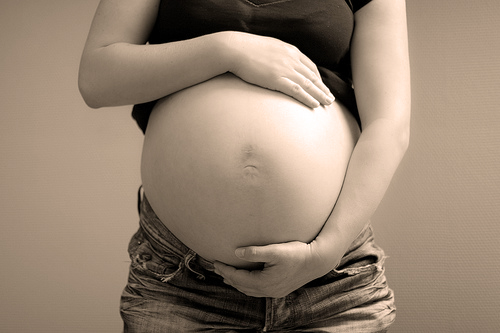? ? ? ? ? การวางแผนคลอดทางช่องคลอด เมื่อได้ประเมินครรภ์แล้วพบว่าสามารถคลอดทางช่องคลอดได้ การวางแผนการคลอดทางช่องคลอดเริ่มต้นตั้งแต่ การกำหนดนัดวันคลอดซึ่งต้องพิจารณาว่ามีการยืนยันอายุครรภ์ที่แน่นอนจาก
-มีการตรวจวัด Crown-lump length จากคลื่นเสียงความถี่สูงขณะอายุครรภ์ 6-11 สัปดาห์
-มีการตรวจวัดยืนยันอายุครรภ์จากคลื่นเสียงความถี่สูงขณะอายุครรภ์ 13-20 สัปดาห์
-มีการตรวจการได้ยินเสียงหัวใจทารกจากหูฟัง (Stethoscope) นานมากกว่า 20 สัปดาห์หรือจาก Doptone นานมากกว่า 30 สัปดาห์ (ปกติจะเริ่มฟังเสียงหัวใจทารกจากจากหูฟัง (Stethoscope) ได้ที่อายุครรภ์ 20 สัปดาห์ และเริ่มฟังเสียงหัวใจทารกจาก Doptone ได้ที่อายุครรภ์ 10-12 สัปดาห์ ดังนั้นเมื่อตรวจพบแสดงว่าอายุครรภ์น่าจะครบกำหนดคลอดแล้ว)
-มีการตรวจปัสสาวะยืนยันการตั้งครรภ์มานานมากกว่า 36 สัปดาห์3 (การตรวจปัสสาวะเพื่อยืนยันการตั้งครรภ์ มักตรวจเมื่อประจำเดือนเริ่มขาด ซึ่งนับอายุครรภ์ได้ 4 สัปดาห์ ดังนั้นหากตรวจปัสสาวะยืนยันการตั้งครรภ์มานานมากกว่า 36 สัปดาห์ แสดงว่าครรภ์ครบกำหนดแล้ว)
? ? ? ? ? เมื่อมั่นใจในอายุครรภ์ว่าครบกำหนดแล้ว การเลือกอายุครรภ์ที่จะนัดชักนำการคลอด แนะนำให้เลือกอายุครรภ์ที่ 38-39 สัปดาห์1,4-7เนื่องจากจะพบภาวะแทรกซ้อนของมารดาและทารกน้อยกว่า โดยอัตราการพบ macrosomia และ meconium เพิ่มขึ้นเมื่ออายุครรภ์มากกว่า 38 สัปดาห์ อัตราการติดเชื้อ chorioamnionitis และ endomyometritis สูงขึ้นเมื่ออายุครรภ์มากกว่า 40 สัปดาห์ และอัตราทารกในครรภ์เสียชีวิตมากขึ้นเมื่ออายุครรภ์มากกว่า 41 สัปดาห์ และหากชักนำการคลอดในครรภ์หลังที่ปากมดลูกมีความพร้อมในอายุครรภ์ 39 สัปดาห์พบว่าอาจลดอัตราการผ่าตัดคลอดลงได้7 ในกรณีที่วางกำหนดการคลอดได้แล้วจะต้องร่วมกับการตรวจประเมินปากมดลูกด้วย โดยอัตราการผ่าตัดคลอดจะแปรผกผันกับการเปิดของปากมดลูก (cervical dilatation) หากปากมดลูกไม่เปิดโอกาสผ่าตัดคลอดถึงร้อยละ 50 ขณะที่หากปากมดลูกเปิดมากกว่า 3 เซนติเมตรโอกาสผ่าตัดคลอดน้อยกว่าร้อยละ 10 ดังนั้นเมื่อพิจารณาความปลอดภัยของทารกและโอกาสเกิดภาวะแทรกซ้อนของทารกต่ำ ควรเลือกนัดชักนำการคลอดเมื่อปากมดลูกเปิดมากกว่า 3 เซนติเมตรขึ้นไป ยกเว้นมีข้อบ่งชี้ทางสูติศาสตร์ที่จำเป็นต้องชักนำการคลอด นั่นคือ อาจเลื่อนกำหนดการคลอดไปอีก 1 สัปดาห์และประเมินปากมดลูกซ้ำ อย่างไรก็ตาม การชักนำการคลอดพบว่าเพิ่มอัตราการเกิดการตกเลือดหลังคลอดชนิดรุนแรงสูงกว่าโดยมี odds ratio (OR) เท่ากับ 1.71 (95% confidence interval (CI) เท่ากับ 1.56-1.88)8 หลังจากตรวจพบความพร้อมของปากมดลูกและกำหนดคลอดได้ ขณะที่นัดผู้คลอดมานอนโรงพยาบาลจำเป็นต้องดูแลในห้องคลอดเสมือนผู้คลอดครรภ์เสี่ยงสูง เนื่องจากมีการใช้ยากระตุ้นการหดรัดตัวของมดลูกซึ่งอาจพบร่วมกับการเจาะถุงน้ำคร่ำ ในการใช้ยากระตุ้นการหดรัดตัวของมดลูกนั้นที่นิยมใช้ได้แก่ การให้ oxytocin แนะนำให้ใช้ตามเภสัชศาสตร์ของยา โดยเริ่มต้นที่ 2 mU/min เพิ่มขนาดครั้งละ 2 mU/min จนกระทั่งได้การหดรัดตัวของมดลูกดี และขนาดสูงสุดที่ใช้คือ 20-30 mU/min9 สำหรับการเจาะถุงน้ำคร่ำ หากทำการเจาะในระยะแรกของการคลอด จะลดระยะเวลาของการคลอดในระยะที่หนึ่ง ลดการใช้ยากระตุ้นการหดรัดตัวของมดลูก โดยไม่พบความแตกต่างในอุบัติการณ์ของ nonreassuring fetal heart rate และผลลัพธ์ของทารก แต่พบมีอัตราการผ่าตัดคลอดสูงขึ้น10? ในการติดตามการคลอดในระยะที่หนึ่งควรใช้ partogram ในการประเมินความผิดปกติของการคลอด หากพบความผิดปกติให้แก้ไขตามสาเหตุและทำการผ่าตัดเมื่อมีข้อบ่งชี้ทางสูติศาสตร์
หนังสืออ้างอิง
- Kolas T, Saugstad OD, Daltveit AK, Nilsen ST, Oian P. Planned cesarean versus planned vaginal delivery at term: comparison of newborn infant outcomes. Am J Obstet Gynecol 2006;95:1538-43.
- Clark SL, Miller DD, Belfort MA, Dildy GA, Frye DK, Meyers JA. Neonatal and maternal outcomes associated with elective term delivery.? Am J Obstet Gynecol 2009;200:156.e1-4.
- Holm LD. Provider documentation and elective induction of labor: a 6-month experience at a university medical center. Am J Obstet Gynecol ?2009;200:336.e1-5.
- Nicholson JM, Yeager DL, Macones G. A preventive approach to obstetric care in a rural hospital: association between higher rates of preventive labor induction and lower rates of cesarean delivery. Ann Fam Med 2007;5:310-9.
- Caughey AB. Preventive induction of labor: potential benefits if proved effective. Ann Fam Med 2007;5:292-3.
- Caughey AB, Washington AE, Laros RK Jr. Neonatal complications of term pregnancy: rates by gestational age increase in a continuous, not threshold, fashion. Am J Obstet Gynecol 2005;192:185-90.
- Caughey AB, Musci TJ. Complications of term pregnancies beyond 37 weeks of gestation. Obstet Gynecol 2004;103:57-62.
- Al-Zirqi I, Vangen S, Fors?n L, Stray-Pedersen B. Effects of onset of labor and mode of delivery on severe postpartum hemorrhage. Am J Obstet Gynecol 2009;201: 273.e1-9.
- Hayes EJ, Weinstein L. Improving patient safety and uniformity of care by a standardized regimen for the use of oxytocin. Am J Obstet Gynecol 2008;198:622.e1-7.
- Fraser WD, Turcot L, Krauss I, Brisson-Carrol G. Amniotomy for shortening spontaneous labour. Cochrane Database Syst Rev 2007;4:CD006167.
- Flood KM, Said S, Geary M, Robson M, Fitzpatrick C, Malone FD. Changing trends in peripartum hysterectomy over the last 4 decades. Am J Obstet Gynecol 2009;200:632.e1-6.
- Clark SL, Belfort MA, Dildy GA, Herbst MA, Meyers JA, Hankins GD. Maternal death in the 21st century: causes, prevention, and relationship to cesarean delivery. Am J Obstet Gynecol 2008;199:36.e1-5.
- Rosen T. Placeta accreta and cesarean scar pregnancy: overlooked costs of the rising cesarean section rate. Clin Perinatol 2008;35:519-29.
- Phipps MG,?Watabe B,?Clemons JL,?Weitzen S,?Myers DL.? Risk factors for bladder injury during cesarean delivery. ?Obstet Gynecol 2005;105:156-60.
- Tulandi T, Agdi M, Zarei A, Miner L, Sikirica V. Adhesion development and morbidity after repeat cesarean delivery. Am J Obstet Gynecol 2009;201:56.e1-6.
- Coonrod DV, Drachman D, Hobson P, Manriquez M. Nulliparous term singleton vertex cesarean delivery rates: institutional and individual level predictors. Am J Obstet Gynecol 2008;198:694.e1-11.
- National Institutes of Health state-of-the-science conference statement. Cesarean delivery on maternal request. Obstet Gynecol?2006;107:1386-97.
- Nygaard I. Urinary incontinence: Is cesarean delivery protective?. ?Semin Perinatol?2006;30:267-71.
- Lee YM, D’Alton ME Cesarean delivery on maternal request: the impact on mother and newborn. Clin Perinatol 2008;35:505-18.
บทความโดย รศ.นายแพทย์ภาวิน พัวพรพงษ์

